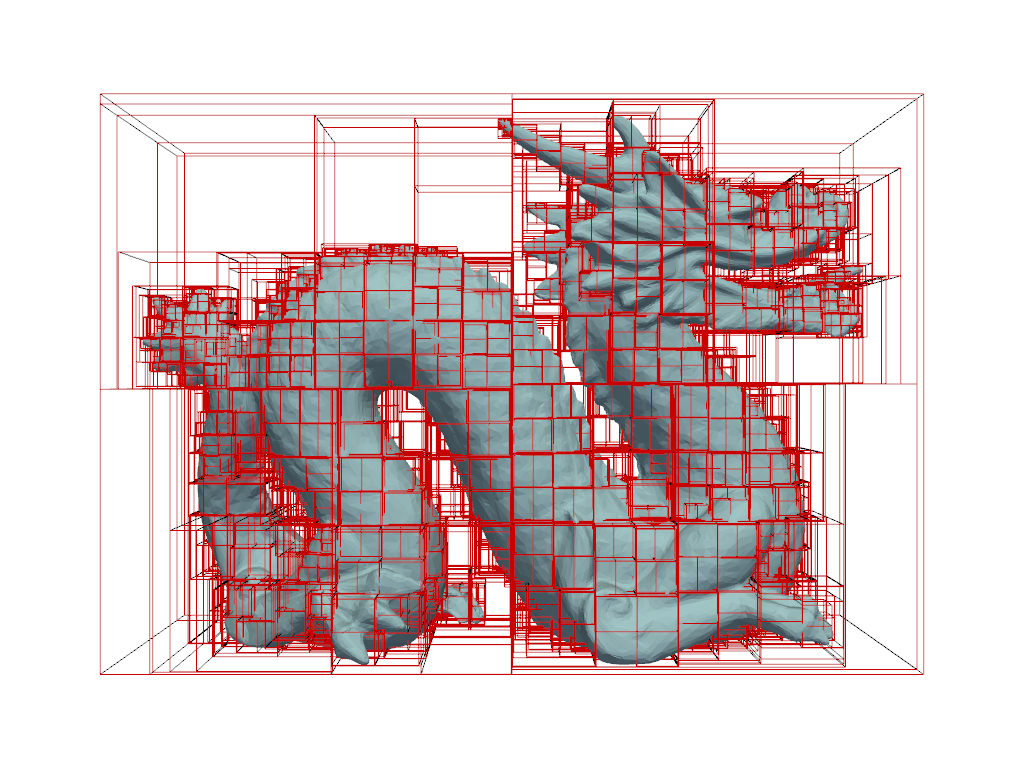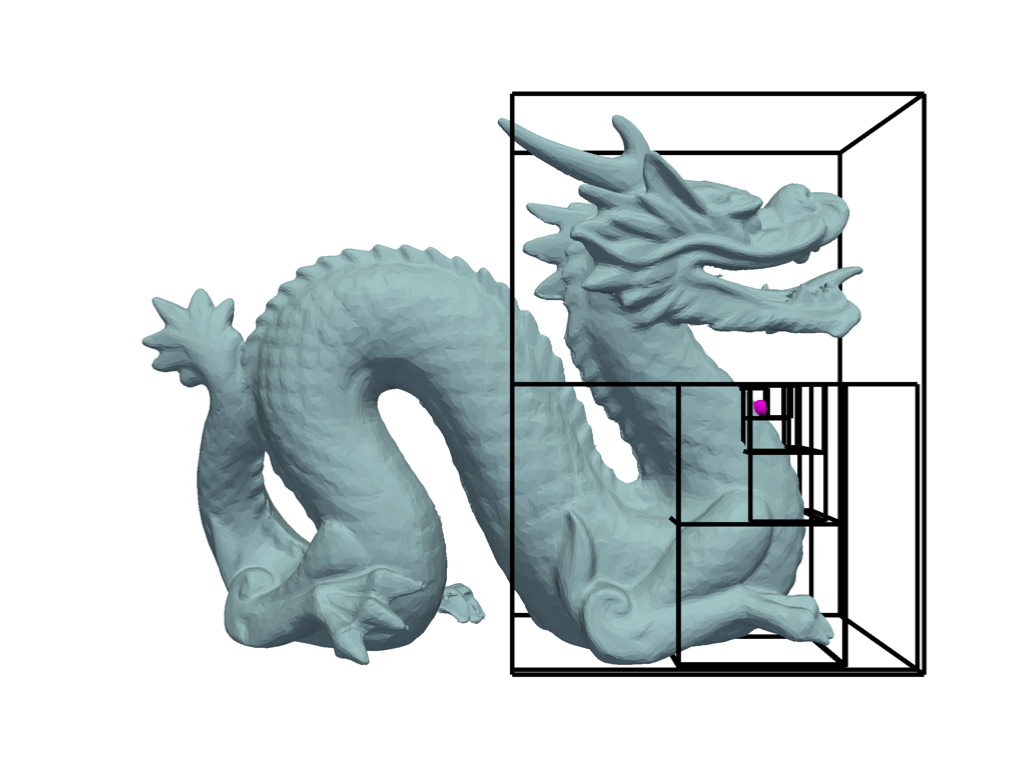Note
Go to the end to download the full example code.
AABB Trees#
Building an axis-aligned bounding box (AABB) for a given trimesh
import numpy as np
import pyvista as pv
import mirage as mr
import mirage.vis as mrv
def ray_triangle_intersection(ray_origin, ray_direction, vertices):
vertex0 = vertices[0, :]
vertex1 = vertices[1, :]
vertex2 = vertices[2, :]
EPSILON = 1e-6
edge1, edge2 = vertex1 - vertex0, vertex2 - vertex0
h = np.cross(ray_direction, edge2)
a = np.dot(edge1, h)
if -EPSILON < a < EPSILON:
return None # This means the ray is parallel to this triangle.
f = 1.0 / a
s = ray_origin - vertex0
u = f * np.dot(s, h)
if u < 0.0 or u > 1.0:
return None
q = np.cross(s, edge1)
v = f * np.dot(ray_direction, q)
if v < 0.0 or u + v > 1.0:
return None
t = f * np.dot(edge2, q)
if t > EPSILON: # ray intersection
intersection_point = ray_origin + ray_direction * t
return t, u, v, intersection_point
else: # This means that there is a line intersection but not a ray intersection.
return None
def ray_box_intersection(ray_origin, ray_direction, box_lims):
box_min = np.array([box_lims[0], box_lims[2], box_lims[4]])
box_max = np.array([box_lims[1], box_lims[3], box_lims[5]])
t_min = np.zeros(3, dtype=np.float32)
t_max = np.zeros(3, dtype=np.float32)
for i in range(3): # Process each dimension independently
if ray_direction[i] != 0:
t_min[i] = (box_min[i] - ray_origin[i]) / ray_direction[i]
t_max[i] = (box_max[i] - ray_origin[i]) / ray_direction[i]
else:
t_min[i] = float('-inf') if ray_origin[i] < box_min[i] else float('inf')
t_max[i] = float('inf') if ray_origin[i] > box_max[i] else float('-inf')
if t_min[i] > t_max[i]:
t_min[i], t_max[i] = t_max[i], t_min[i]
final_t_min = max(t_min)
final_t_max = min(t_max)
if final_t_min > final_t_max or final_t_max < 0:
return None, None # No intersection
# Calculate intersection points
intersection_min = ray_origin + final_t_min * ray_direction
return intersection_min, final_t_min
def points_in_box(points, bounds) -> np.ndarray[bool]:
check_pts = points[:, 0] > bounds[0]
check_pts &= points[:, 0] < bounds[1]
check_pts &= points[:, 1] > bounds[2]
check_pts &= points[:, 1] < bounds[3]
check_pts &= points[:, 2] > bounds[4]
check_pts &= points[:, 2] < bounds[5]
ret = np.argwhere(check_pts).flatten()
return ret
def build_boxes(
all_points: np.ndarray, split_verts: np.ndarray[int], max_depth: int, depth: int = 0
):
if depth == max_depth:
return
boxes = {}
if split_verts.size == 0:
return
mins = np.min(all_points[split_verts, :], axis=0)
maxs = np.max(all_points[split_verts, :], axis=0)
split_axis = np.argmax(maxs - mins)
mid_pt = mins[split_axis] + (maxs[split_axis] - mins[split_axis]) / 2
if split_axis == 0:
boxes['left_bounds'] = (mins[0], mid_pt, mins[1], maxs[1], mins[2], maxs[2])
boxes['right_bounds'] = (mid_pt, maxs[0], mins[1], maxs[1], mins[2], maxs[2])
if split_axis == 1:
boxes['left_bounds'] = (mins[0], maxs[0], mins[1], mid_pt, mins[2], maxs[2])
boxes['right_bounds'] = (mins[0], maxs[0], mid_pt, maxs[1], mins[2], maxs[2])
if split_axis == 2:
boxes['left_bounds'] = (mins[0], maxs[0], mins[1], maxs[1], mins[2], mid_pt)
boxes['right_bounds'] = (mins[0], maxs[0], mins[1], maxs[1], mid_pt, maxs[2])
boxes['left_members'] = points_in_box(all_points, boxes['left_bounds'])
boxes['right_members'] = points_in_box(all_points, boxes['right_bounds'])
boxes['depth'] = depth
if depth + 1 == max_depth:
return boxes
boxes['left_leaves'] = build_boxes(
all_points, boxes['left_members'], max_depth=max_depth, depth=depth + 1
)
boxes['right_leaves'] = build_boxes(
all_points, boxes['right_members'], max_depth=max_depth, depth=depth + 1
)
if boxes['left_leaves'] is None:
del boxes['left_leaves']
if boxes['right_leaves'] is None:
del boxes['right_leaves']
return boxes
def aggregate_children(pl, boxes, block):
block.extend(
[pv.Box(bounds=boxes['left_bounds']), pv.Box(bounds=boxes['right_bounds'])]
)
if 'left_leaves' in boxes:
aggregate_children(pl, boxes['left_leaves'], block)
if 'right_leaves' in boxes:
aggregate_children(pl, boxes['right_leaves'], block)
def trace_indices(ray_origin, ray_direction, face_indices, faces_vertices):
f, v = faces_vertices
good_res = []
for fi in face_indices:
fiv = v[f[fi]]
res = ray_triangle_intersection(ray_origin, ray_direction, fiv)
if res is not None:
good_res.append(res)
return good_res
def trace_children(pl, ray_origin, ray_direction, boxes, faces_vertices):
lpt, ltime = ray_box_intersection(ray_origin, ray_direction, boxes['left_bounds'])
rpt, rtime = ray_box_intersection(ray_origin, ray_direction, boxes['right_bounds'])
go_left = None
if lpt is not None: # and rpt is None (implied)
go_left = True
if rpt is not None: # and lpt is None (implied)
go_left = False
if lpt is not None and rpt is not None:
if ltime < rtime:
go_left = True
if rtime < ltime:
go_left = False
if go_left:
if 'left_leaves' in boxes:
pl.add_mesh(
pv.Box(bounds=boxes['left_bounds']),
line_width=10,
style='wireframe',
color='k',
)
return trace_children(
pl, ray_origin, ray_direction, boxes['left_leaves'], faces_vertices
)
else:
return trace_indices(
ray_origin, ray_direction, boxes['left_members'], faces_vertices
)
else:
if 'right_leaves' in boxes:
pl.add_mesh(
pv.Box(bounds=boxes['right_bounds']),
line_width=10,
style='wireframe',
color='k',
)
return trace_children(
pl, ray_origin, ray_direction, boxes['right_leaves'], faces_vertices
)
else:
return trace_indices(
ray_origin, ray_direction, boxes['right_members'], faces_vertices
)
obj = mr.SpaceObject('stanford_dragon.obj')
obj.v = obj.v.astype(np.float32)
mr.tic('Building AABB')
boxes = build_boxes(
obj.face_centroids, np.arange(obj.face_centroids.shape[0]), max_depth=11
)
mr.toc()
pl = pv.Plotter()
mrv.render_spaceobject(pl, obj, opacity=1.0)
block = pv.MultiBlock()
aggregate_children(pl, boxes, block)
pl.add_mesh(block, style='wireframe', color='r')
pl.camera.position = (3.5, 0.0, 0.0)
pl.show()

Building AABB: 1.27e+00 seconds
Now that we have some boxes, let’s see how much faster they make our raytracing
ray_origin = 10 * np.array([0.1, 1.0, -0.1])
ray_direction = -mr.hat(ray_origin)
mr.tic('Brute force tracing')
good_res = []
for f in obj.f:
x = ray_triangle_intersection(ray_origin, ray_direction, obj.v[f])
if x is not None:
good_res.append(x)
mr.toc()
pl = pv.Plotter()
mrv.render_spaceobject(pl, obj, opacity=1.0)
for x in good_res:
mrv.scatter3(pl, x[-1], point_size=40, color='m')
mr.tic('AABB tracing')
res = trace_children(pl, ray_origin, ray_direction, boxes, (obj.f, obj.v))
mr.toc()
for x in res:
mrv.scatter3(pl, x[-1], point_size=100, color='lime', opacity=0.2)
pl.camera.position = (3.5, 0.0, 0.0)
pl.show()

Brute force tracing: 2.66e+00 seconds
AABB tracing: 1.03e-02 seconds
Total running time of the script: (0 minutes 4.672 seconds)
